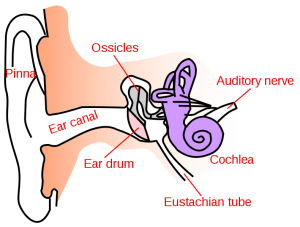Eustachian tube dysfunction refers to when the pressure of the middle ear is unable to equalize with atmospheric pressure. It can cause a muffling of one’s hearing and can also cause ear pain (otalgia), facial pain and headache.
The eustachian tube connects the middle ear to the nasopharynx (see diagram). It is composed partly of bone (near the middle ear) and partly of cartilage. There are 4 muscles that insert into the eustachian tube controlling its ability to open and close. These are the salpingopharyngeus, tensor tympani, levator veli palatini and tensor veli palatini. These muscles are related to the pharynx so each time you swallow or yawn, the ears (in normal cases) will make a mild clicking sound which represents the temporary opening of the eustachian tube to equalize the pressure. It is thought that eustachian tube dysfunction is a result of disruption of the normal tone of these muscles affecting their ability to contract optimally (1). Malfunction of these muscles may also affect the ear’s ability to drain fluid. As soon as the tone returns to normal, the opening and closure mechanism of the eustachian tube is restored and pressure equalization and drainage of any fluids can resume. Eustachian tube dysfunction can occur with or without middle ear infection (1).
Middle ear infections can also occur in adults. The eustachian tube is responsible for draining fluid of the middle ear, so sometimes when you have an upper respiratory infection (or a cold), mucus and bacteria get trapped in the eustachian tube and the blockage results in an inner ear infection. How can chiropractic help with ear pain?
How can chiropractic help with ear pain?
Ear pain can occur for a variety of reasons. It can result from eustachian tube dysfunction (as discussed above), from dysfunction of the joints in the neck, dysfunction of the temporomandibular joint (or TMJ) and ear infection, for example. A chiropractic examination can identify mechanical causes/contributors of your ear pain and adjustments to the affected areas will help to restore normal function. For example, the ear itself can be adjusted, the neck can be adjusted and the TMJ can be adjusted if dysfunction is found there. A few treatments may be required before you notice any difference. Long standing mechanical issues take a longer time to normalize than newer mechanical issues. Often times, people have more than one mechanical issue that needs to be addressed. Depending on the cause of the ear pain, there are also different exercises that may help.
There is preliminary evidence that chiropractic adjustments to the upper four vertebrae of the neck improve symptoms of middle ear infection (3). The tensor veli palatini muscle is innervated by a branch of the trigeminal nerve which has branches to the C1-C4 nerve roots. The mechanism of benefit is thought to be from freeing neurological compromise to the tensor veli palatini such that its normal tone is restored (3).
Interesting study:
In children with recurrent ear infections, chewing xylitol gum daily appears to reduce the occurrence of middle ear infection by 40% compared to chewing sucrose gum (2). Xylitol also inhibits the growth of Streptococcus pneumoniae.
Dietary Suggestions:
-
stay well hydrated
-
eliminate dairy foods (dairy may thicken and increase mucus making it more difficult for an infected ear to drain)
-
1) Murphy D & Gay, C (2011). Manual therapy and ear pain: a report of four cases. J Can Chirop Assoc; 55(1):40-46.
-
2) Uhari, M, Kontiokari, T, Koskela, M & Niemela, M (1996). Xylitol chewing gum in prevention of acute otitis media: double blind randomised trial. BGJ; 313:1180-4.
-
3) Fallon (1997). Preliminary evidence SMT may benefit some children with otitis media. J Clin Chiro Ped; 2(2).
Dr. Elisabeth Miron
Looking for a chiropractor? Check out www.MironDC.ca